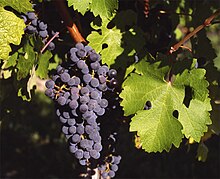Ampelography

The ampelography or Ampelografie (from Greek ampelos = vine , same name, the personification of the vine in Greek mythology ), German grape varieties or Oenology is the doctrine of the determination and description of varieties and their scientific classification. It is a branch of oenology and pomology .
criteria
In ampelography, the characteristic features of the grapevine are indicated as follows: name, synonyms, homeland, distribution, general characteristics of the vine and grape berry . The characteristics of two varieties sometimes only differ by nuances.
history
The science of ampelography began to develop in earnest in the 19th century, when it was necessary to combat vine diseases and pests such as phylloxera as effectively as possible. Differences observed in connection with resistance made it necessary to study and describe the varieties in more detail.
However, the first scientific use was not introduced until 1952 by Pierre Galet . He created a system for classifying vines based on objective characteristics and used it to describe 9600 different grape varieties.
Newer approaches use the genetic fingerprint to grape varieties to identify and reconstruct their distribution history.
literature
- Pierre Galet : Dictionnaire encyclopédique des cépages . 1st edition. Hachette Livre, 2000, ISBN 2-01-236331-8 (French).
- Hermann Goethe : Handbuch der Ampelographie: Description and classification of the vines and grape varieties cultivated up to now with indication of their synonyms, cultural relationships and type of use . Verlag P. Parey, Berlin 1878 (2nd edition 1887, reprinted as paperback 2012, ISBN 9781279175408 ).
